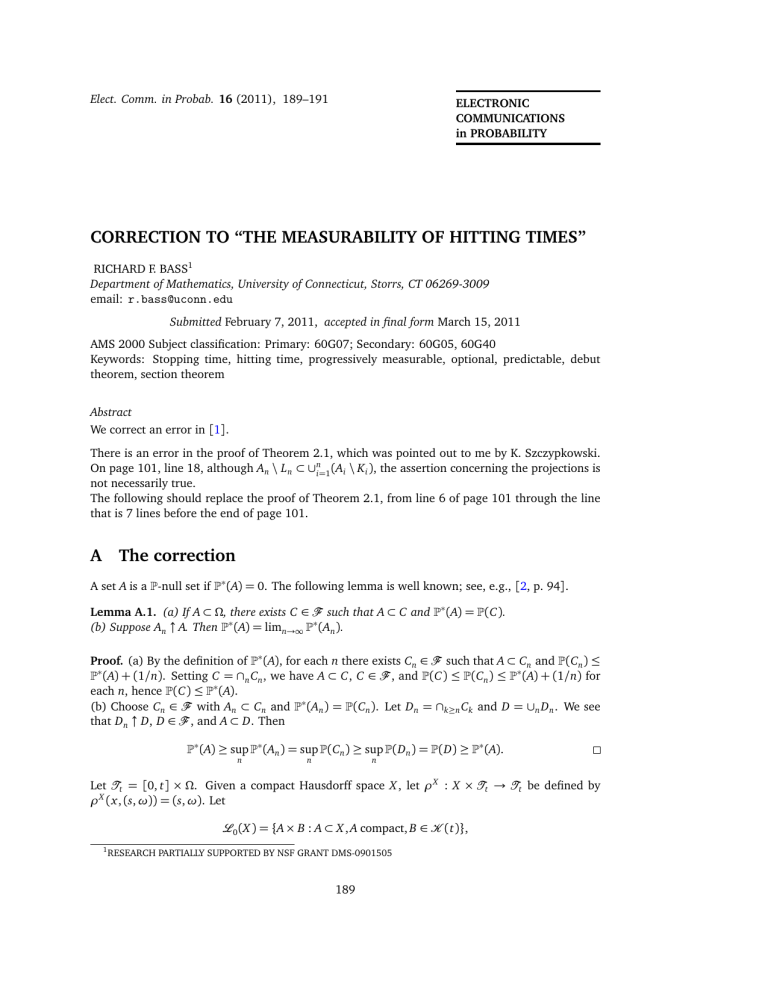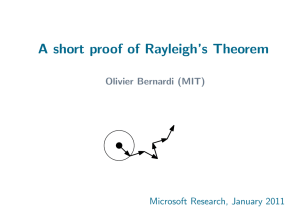CORRECTION TO “THE MEASURABILITY OF HITTING TIMES”
advertisement

Elect. Comm. in Probab. 16 (2011), 189–191
ELECTRONIC
COMMUNICATIONS
in PROBABILITY
CORRECTION TO “THE MEASURABILITY OF HITTING TIMES”
RICHARD F. BASS1
Department of Mathematics, University of Connecticut, Storrs, CT 06269-3009
email: r.bass@uconn.edu
Submitted February 7, 2011, accepted in final form March 15, 2011
AMS 2000 Subject classification: Primary: 60G07; Secondary: 60G05, 60G40
Keywords: Stopping time, hitting time, progressively measurable, optional, predictable, debut
theorem, section theorem
Abstract
We correct an error in [1].
There is an error in the proof of Theorem 2.1, which was pointed out to me by K. Szczypkowski.
On page 101, line 18, although An \ L n ⊂ ∪ni=1 (Ai \ Ki ), the assertion concerning the projections is
not necessarily true.
The following should replace the proof of Theorem 2.1, from line 6 of page 101 through the line
that is 7 lines before the end of page 101.
A
The correction
A set A is a P-null set if P∗ (A) = 0. The following lemma is well known; see, e.g., [2, p. 94].
Lemma A.1. (a) If A ⊂ Ω, there exists C ∈ F such that A ⊂ C and P∗ (A) = P(C).
(b) Suppose An ↑ A. Then P∗ (A) = limn→∞ P∗ (An ).
Proof. (a) By the definition of P∗ (A), for each n there exists Cn ∈ F such that A ⊂ Cn and P(Cn ) ≤
P∗ (A) + (1/n). Setting C = ∩n Cn , we have A ⊂ C, C ∈ F , and P(C) ≤ P(Cn ) ≤ P∗ (A) + (1/n) for
each n, hence P(C) ≤ P∗ (A).
(b) Choose Cn ∈ F with An ⊂ Cn and P∗ (An ) = P(Cn ). Let Dn = ∩k≥n Ck and D = ∪n Dn . We see
that Dn ↑ D, D ∈ F , and A ⊂ D. Then
P∗ (A) ≥ sup P∗ (An ) = sup P(Cn ) ≥ sup P(Dn ) = P(D) ≥ P∗ (A).
n
n
n
Let T t = [0, t] × Ω. Given a compact Hausdorff space X , let ρ X : X × T t → T t be defined by
ρ X (x, (s, ω)) = (s, ω). Let
L0 (X ) = {A × B : A ⊂ X , A compact, B ∈ K (t)},
1
RESEARCH PARTIALLY SUPPORTED BY NSF GRANT DMS-0901505
189
190
Electronic Communications in Probability
L1 (X ) the class of finite unions of sets in L0 (X ), and L (X ) the class of intersections of countable
decreasing sequences in L1 (X ). Let Lσ (X ) be the class of unions of countable increasing sequences of sets in L (X ) and Lσδ (X ) the class of intersections of countable decreasing sequences
of sets in Lσ (X ).
Lemma A.2. If A ∈ B[0, t] × F t , there exists a compact Hausdorff space X and B ∈ Lσδ (X ) such
that A = ρ X (B).
Proof. If A ∈ K (t), we take X = [0, 1], the unit interval with the usual topology and B = X × A.
Thus the collection M of subsets of B[0, t] × F t for which the lemma is satisfied contains K (t).
We will show that M is a monotone class.
Suppose An ∈ M with An ↓ A. ThereQexist compact Hausdorff spaces X n and sets Bn ∈ Lσδ (X n )
∞
such that An = ρ X n (Bn ). Let X =
n=1 X n be furnished with the product topology. Let τn :
X × T t → X n × T t be defined by τn (x, (s, ω)) = (x n , (s, ω)) if x = (x 1 , x 2 , . . .). Let Cn = τ−1
n (Bn )
and let C = ∩n Cn . It is easy to check that L (X ) is closed under the operations of finite unions
and intersections, from which it follows that C ∈ Lσδ (X ). If (s, ω) ∈ A, then for each n there
exists x n ∈ X n such that (x n , (s, ω)) ∈ Bn . Note that ((x 1 , x 2 , . . .), (s, ω)) ∈ C and therefore (s, ω) ∈
ρ X (C). It is straightforward that ρ X (C) ⊂ A, and we conclude A ∈ M .
Now suppose An ∈ M with An ↑ A. Let X n and Bn be as before. Let X 0 = ∪∞
n=1 X n × {n} with the
topology generated by {G × {n} : G open in X n }. Let X be the one point compactification of X 0 .
We can write Bn = ∩m Bnm with Bnm ∈ Lσ (X n ). Let
Cnm = {((x, n), (s, ω)) ∈ X × T t : x ∈ X n , (x, (s, ω)) ∈ Bnm },
Cn = ∩m Cnm , and C = ∪n Cn . Then Cnm ∈ Lσ (X ) and so Cn ∈ Lσδ (X ).
If ((x, p), (s, ω)) ∈ ∩m ∪n Cnm , then for each m there exists nm such that ((x, p), (s, ω)) ∈ Cnm m .
This is only possible if nm = p for each m. Thus ((x, p), (s, ω)) ∈ ∩m C pm = C p ⊂ C. The other
inclusion is easier and we thus obtain C = ∩m ∪n Cnm , which implies C ∈ Lσδ (X ). We check that
A = ρ X (C) along the same lines, and therefore A ∈ M .
If I 0 (t) is the collection of sets of the form [a, b) × C, where a < b ≤ t and C ∈ F t , and I (t) is
the collection of finite unions of sets in I 0 (t), then I (t) is an algebra of sets. We note that I (t)
generates the σ-field B[0, t] × F t . A set in I 0 (t) of the form [a, b) × C is the union of sets in
K 0 (t) of the form [a, b − (1/m)] × C, and it follows that every set in I (t) is the increasing union
of sets in K (t). Since M is a monotone class containing K (t), then M contains I (t). By the
monotone class theorem, M = B[0, t] × F t .
The works of Suslin and Lusin present a different approach to the idea of representing Borel sets
as projections; see, e.g., [4, p. 88] or [3, p. 284].
Lemma A.3. If A ∈ B[0, t] × F t , then A is t-approximable.
Proof. We first prove that if H ∈ L (X ), then ρ X (H) ∈ Kδ . If H ∈ L1 (X ), this is clear. Suppose that
H n ↓ H with each H n ∈ L1 (X ). If (s, ω) ∈ ∩n ρ X (H n ), there exist x n ∈ X such that (x n , (s, ω)) ∈ H n .
Then there exists a subsequence such that x nk → x ∞ by the compactness of X . Now (x nk , (s, ω)) ∈
H nk ⊂ H m for nk larger than m. For fixed ω, {(x, s) : (x, (s, ω)) ∈ H m } is compact, so (x ∞ , (s, ω)) ∈
H m for all m. This implies (x ∞ , (s, ω)) ∈ H. The other inclusion is easier and therefore ∩n ρ X (H n ) =
ρ X (H). Since ρ X (H n ) ∈ Kδ (t), then ρ X (H) ∈ Kδ (t). We also observe that for fixed ω, {(x, s) :
(x, (s, ω)) ∈ H} is compact.
Hitting times
191
Now suppose A ∈ B[0, t]×F t . Then by Lemma A.2 there exists a compact Hausdorff space X and
B ∈ Lσδ (X ) such that A = ρ X (B). We can write B = ∩n Bn and Bn = ∪m Bnm with Bn ↓ B, Bnm ↑ Bn ,
and Bnm ∈ L (X ).
Let a = P∗ (π(A)) = P∗ (π ◦ ρ X (B)) and let " > 0. By Lemma A.1,
P∗ (π ◦ ρ X (B ∩ B1m )) ↑ P∗ (π ◦ ρ X (B ∩ B1 )) = P∗ (π ◦ ρ X (B)) = a.
Take m large enough so that P∗ (π ◦ ρ X (B ∩ B1m )) > a − ", let C1 = B1m , and D1 = B ∩ C1 .
We proceed by induction. Suppose we are given sets C1 , . . . , Cn−1 and sets D1 , . . . , Dn−1 with
∗
X
Dn−1 = B ∩ (∩n−1
i=1 Ci ), P (π ◦ ρ (Dn−1 )) > a − ", and each Ci = Bimi for some mi . Since Dn−1 ⊂ B ⊂
Bn , by Lemma A.1
P∗ (π ◦ ρ X (Dn−1 ∩ Bnm )) ↑ P∗ (π ◦ ρ X (Dn−1 ∩ Bn )) = P∗ (π ◦ ρ X (Dn−1 )).
We can take m large enough so that P∗ (π ◦ ρ X (Dn−1 ∩ Bnm )) > a − ", let Cn = Bnm , and Dn =
Dn−1 ∩ Cn .
If we let Gn = C1 ∩ · · · ∩ Cn and G = ∩n Gn = ∩n Cn , then each Gn is in L (X ), hence G ∈ L (X ).
Since Cn ⊂ Bn , then G ⊂ ∩n Bn = B. Each Gn ∈ L (X ) and so by the first paragraph of this proof,
for each fixed ω and n, {(x, s) : (x, (s, ω)) ∈ Gn } is compact. Hence by a proof very similar to that
of Lemma 2.2, π ◦ ρ X (Gn ) ↓ π ◦ ρ X (G). Using the first paragraph of this proof and Lemma 2.2, we
see that
P(π ◦ ρ X (G)) = lim P(π ◦ ρ X (Gn )) ≥ lim P∗ (π ◦ ρ X (Dn )) ≥ a − ".
Using the first paragraph of this proof once again, we see that A is t-approximable.
Proof of Theorem 2.1. Let E be a progressively measurable set and let A = E ∩ ([0, t] × Ω).
By Lemma A.3, A is t-approximable. By Proposition 2.3, (D E ≤ t) = π(A) ∈ F t . Because t was
arbitrary, we conclude D E is a stopping time.
Acknowledgement. I would like to thank the referee for valuable suggestions.
References
[1] R.F. Bass. The measurability of hitting times. Electron. Comm. Prob. 15 (2010) 99–105.
MR2606507 , http://www.math.washington.edu/~ejpecp/ECP/viewarticle.php?id=
2181&layout=abstract. .
[2] K. Bichteler. Integration: a Functional Approach. Birkhäuser, Basel, 1998. MR1635816
[3] D.L. Cohn. Measure Theory. Birkhäuser, Boston, 1980. MR0578344
[4] I. Fonseca and G. Leoni. Modern Methods in the Calculus of Variations: L p Spaces. Springer,
New York, 2007. MR2341508







